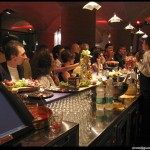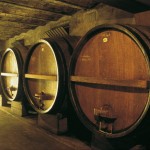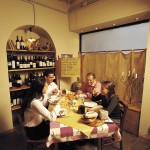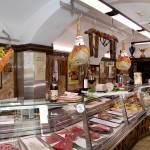In 2006, Torino was the host of the Winter Olympics. To prepare for this event, the city of Torino and the region Piemonte have made important investments, amongst which a new metro line, that have made the city very attractive and an ideal location to host international events, like the EuroScience Open Forum (ESOF) that took place in July 2010.
On the 17th March 1861 the national unity was proclaimed in Torino, which became the first capital city of Italy. The city would be the capital for four years until 1865, when the centrality of the Government of the Kingdom moved to Florence first, and then to Rome. In 2011 Italy will celebrate 150 years and, once again after 1911 and 1961, Torino is going to celebrate the anniversary with a magnificent even. New cultural venues and many initiatives for the 150th celebrations are in the pipelines. To celebrate the 150th anniversary of Italy, Torino and the entire region have planned many other surprises for 2011: the opening of new cultural venues and green areas, the reopening of historical monuments that have been restored and brought back to their original magnificence, and a calendar of numerous and varied initiatives.
Generally speaking, Torino is a lively city, rich in cultural events and landmarks. Art and history are very much at home in Torino, and this can be seen by the city’s museums and palazzos, its piazzas, courtyards and churches, its urban development works and exhibitions, its historic relics and avant-garde pieces, its traditions and its progress. Many great architects, city planners and landscapers have played a significant role in Torino development over the centuries and even today, the most important names in architecture are called upon to redesign the city and plan alterations.
From the Royal Palace to the Church of Consolata, the Regio Teathre and the Reggia of La Venaria Reale, the cultural itineraries are countless, and never predictable. And there’s an infinite choice of attractions outside the city as well: in Rivoli Castle whose Baroque rooms host the Museum of Contemporary Art; in Canavese where the castles of Agliè and of Masino are gems of post-Renaissance architecture surrounded by beautiful gardens; in the Susa and Chisone Valleys where there are the ancient fortresses of Bard, Fenestrelle and Exilles that barred the way to the Alpine passes. Alternatively there is a very special itinerary taking in abbeys, monasteries and sacred mounts: starting with the Basilica of Superga and the Royal Tombs of the Savoy Family, on Turin’s hills, and the Saint Michael’s Abbey at the mouth of the Susa Valley, some of Piedmont’s symbols recognised all over the world.
The gastronomic side is satisfied with dishes, wines, and products from the best of the region Pimonte tradition. Whether it’s delectable food products or the tempting indulgence of chocolate in all its very many forms, the light breadsticks or the red and white wines, sparkling or still and full-bodied: whether in the mountains, the hills or the city influenced by various cultures, both local and from further afield, Torino offers magnificent cuisine, in every season overflowing with specialities whose origins are in the best regional culinary tradition. This is the delicious capital of the bicerin (the typical chocolate, coffee and cream beverage), of gianduiotti chocolates, of patisserie products, a place that shows aristocratic decorum in the timeless ritual of the aperitif, here invented with Vermouth in 1786. Whatever your taste, you will be delighted by a wine and food tour that takes in historical cafés, wine shops and bars, stores and restaurants along the way, where simple country ingredients fit perfectly with the refinement of royal cuisine. Tasty agnolotti (ravioli), tajarin pasta, risottos, boiled and braised meats, mixed fries, cheeses, desserts: let the feast begin!
The images displayed herein are property of the Turismo Torino e Provincia archive, copyright restrictions apply.
In 2006, Torino was the host of the Winter Olympics. To prepare for this event, the city of Torino and the region Piemonte have made important investments, amongst which a new metro line, that have made the city very attractive and an ideal location to host international events, like the EuroScience Open Forum (ESOF) that took place in July 2010.
On the 17th March 1861 the national unity was proclaimed in Torino, which became the first capital city of Italy. The city would be the capital for four years until 1865, when the centrality of the Government of the Kingdom moved to Florence first, and then to Rome. In 2011 Italy will celebrate 150 years and, once again after 1911 and 1961, Torino is going to celebrate the anniversary with a magnificent even. New cultural venues and many initiatives for the 150th celebrations are in the pipelines. To celebrate the 150th anniversary of Italy, Torino and the entire region have planned many other surprises for 2011: the opening of new cultural venues and green areas, the reopening of historical monuments that have been restored and brought back to their original magnificence, and a calendar of numerous and varied initiatives.
Generally speaking, Torino is a lively city, rich in cultural events and landmarks. Art and history are very much at home in Torino, and this can be seen by the city’s museums and palazzos, its piazzas, courtyards and churches, its urban development works and exhibitions, its historic relics and avant-garde pieces, its traditions and its progress. Many great architects, city planners and landscapers have played a significant role in Torino development over the centuries and even today, the most important names in architecture are called upon to redesign the city and plan alterations.
From the Royal Palace to the Church of Consolata, the Regio Teathre and the Reggia of La Venaria Reale, the cultural itineraries are countless, and never predictable. And there’s an infinite choice of attractions outside the city as well: in Rivoli Castle whose Baroque rooms host the Museum of Contemporary Art; in Canavese where the castles of Agliè and of Masino are gems of post-Renaissance architecture surrounded by beautiful gardens; in the Susa and Chisone Valleys where there are the ancient fortresses of Bard, Fenestrelle and Exilles that barred the way to the Alpine passes. Alternatively there is a very special itinerary taking in abbeys, monasteries and sacred mounts: starting with the Basilica of Superga and the Royal Tombs of the Savoy Family, on Turin’s hills, and the Saint Michael’s Abbey at the mouth of the Susa Valley, some of Piedmont’s symbols recognised all over the world.
With more than 40 museums, Torino will introduce you to many amazing worlds, from Egyptian and oriental artefacts to precious furniture, collections of paintings and the most recent examples of modern art. Some of the most popular museums are the Armoury of the Royal Palace, the Galleria Sabauda, the GAM – Civic Gallery of Modern Art – and the National Museum of Cinema. In addition to these there are the Egyptian Museum, the recent MAO – Museum of Oriental Art, the Museum of the Holy Shroud, and the Borgo e la Rocca Medieovale museum site. Within the confines of Palazzo Madama there is the Civic Museum of Ancient Art, while the Scrigno building by Renzo Piano contains the Pinacoteca Giovanni e Marella Agnelli.
The gastronomic side is satisfied with dishes, wines, and products from the best of the region Pimonte tradition. Whether it’s delectable food products or the tempting indulgence of chocolate in all its very many forms, the light breadsticks or the red and white wines, sparkling or still and full-bodied: whether in the mountains, the hills or the city influenced by various cultures, both local and from further afield, Torino offers magnificent cuisine, in every season overflowing with specialities whose origins are in the best regional culinary tradition. This is the delicious capital of the bicerin (the typical chocolate, coffee and cream beverage), of gianduiotti chocolates, of patisserie products, a place that shows aristocratic decorum in the timeless ritual of the aperitif, here invented with Vermouth in 1786. Whatever your taste, you will be delighted by a wine and food tour that takes in historical cafés, wine shops and bars, stores and restaurants along the way, where simple country ingredients fit perfectly with the refinement of royal cuisine. Tasty agnolotti (ravioli), tajarin pasta, risottos, boiled and braised meats, mixed fries, cheeses, desserts: let the feast begin!




The images displayed herein are property of the Turismo Torino e Provincia archive, copyright restrictions apply.